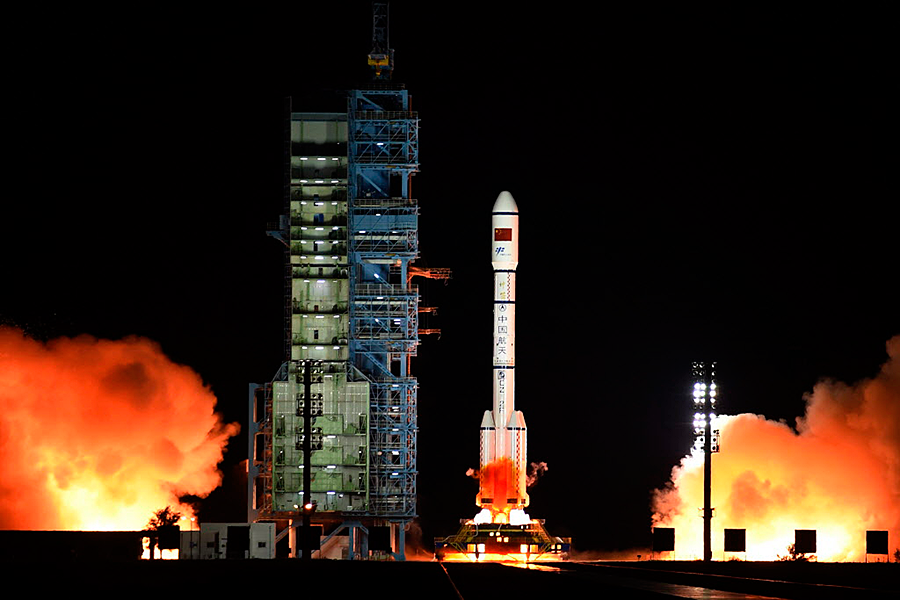Chinese space station set to fall out of sky. How did that happen?
When China launched the Tiangong-1 into orbit in 2011, the country heralded its first space station as a milestone in its bid to be a superpower in space and on Earth.
Six years later, the station will meet an unglamorous, fiery death, apparently with China not at the wheel.
Officials appear to have confirmed the fears of astrophysicists and amateur astronomers that the country has lost control of the 34-foot-long, 8.5 metric ton spacecraft. The unmanned station will likely crash into Earth in late 2017, but scientists don't know where that would be, Chinese officials said in a news conference in the Gobi desert Wednesday.
The odds of debris from the craft injuring a particular person on Earth are less than those of that person being struck by lighting. But China’s apparent admission highlights a question faced by every spacefaring nation: How do you develop end-of-mission plans to avoid posing any threat to humans or other spacecraft? It’s a question even the United States has failed to resolve in the past, ever since parts of Skylab, its first space station, famously crashed in a sparsely populated part of Australia.
In the conference Wednesday, Chinese officials appear to have confirmed the claim of Thomas Dorman, an amateur satellite tracker in El Paso, Texas, who told Space.com in June that China had lost control of the unmanned, decommissioned space station.
“Based on our calculation and analysis, most parts of the space lab will burn up during falling,” Wu Ping, deputy director of China’s manned space engineering office, said, according to Xinhua, the state-run news agency.
Ms. Wu added that China is monitoring the space station for collisions with other objects. Xinhua reported the country’s space agency might need to release an international forecast for where Tiangong-1 will land at a later date, “an uncertainty that seems to indicate the descent is uncontrolled,” writes the Washington Post’s Ben Guarino.
In March, the unmanned space station stopped sending data back to Earth. The suspicions of Mr. Dorman, the amateur astronomer, revealed then led to months of speculation about the fate of the Tiangong, whose name means “Heavenly Palace” in Mandarin. Jonathan McDowell, a Harvard astrophysicist, told The Guardian Wednesday’s announcement indicates China has lost control of the craft and it will reenter Earth “naturally.”
“You really can’t steer these things,” said Dr. McDowell. "Yes there’s a chance it will do damage, it might take out someone’s car, there will be a rain of a few pieces of metal, it might go through someone’s roof, like if a flap fell off a plane, but it is not widespread damage.”
The chances of this happening are “vanishingly small,” Pete Spotts wrote for The Christian Science Monitor in 2011, when NASA announced that a 6.5-ton satellite had run out of fuel before it was expected to reenter Earth several days later.
Falling toward a planet where the ocean makes up 71 percent of the surface, the debris stands a 1-in-2,300 chance of striking anyone at all somewhere on Earth, according to NASA risk estimates. That means the chances of it hitting any specific person – like you – is reportedly about 1 in 21 trillion.
By contrast, the chance of being struck by lightning is 1 in 280,000.
But this natural landing, as well as the expected one of the Chinese space station, run counter to best practices and agreements.
Many [spacefaring nations] agreed on a set of "best practices" guidelines in 2002. In 2008, the UN accepted similar guidelines.
The guidelines are voluntary, but "several countries – the US, France, Japan, Russia, Germany, and others – have put in place national laws" to implement the guidelines, says Brian Weeden, technical adviser to the Secure World Foundation, an organization that aims to foster sustainable use of space.
A retired spacecraft typically meets one of three ends. Space agencies might perform a controlled burn of the craft in the atmosphere, send the craft to a solitary "graveyard orbit" in space well away from operational orbits, or, for larger objects that don’t disintegrate on reentry, send them plunging into the Pacific Ocean, about 2,500 miles off the coast of New Zealand in a spacecraft cemetery known as the "South Pacific Ocean Uninhabited Area.”
But not all retirements have been successful. Famous crashes include a Russian rocket piece landing in Colorado in 2011, debris from a Delta II rocket hitting two woman – one in Texas and one In Turkey – though both were uninjured.
Then there was the Skylab, NASA’s first space station. The spacecraft went spiraling into Earth, landing in a sparsely populated part of western Australia. Then-President Carter issued a public apology to the country, and Australia fined the US $400 for littering. A California radio DJ finally paid the fine in 2009, according to the Post.








